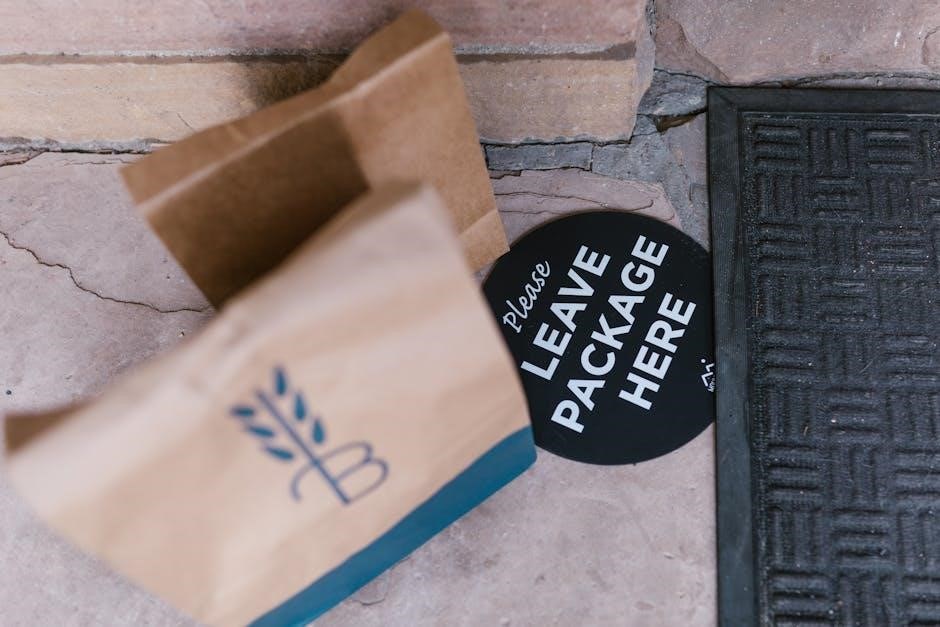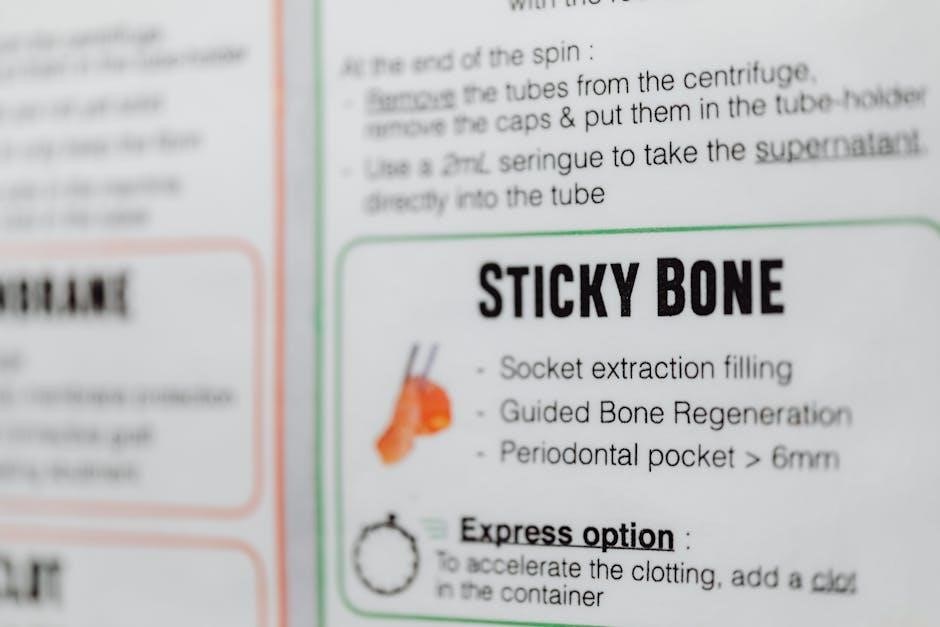surgifoam instructions
Surgifoam is an absorbable gelatin sponge designed to control bleeding during surgical procedures. Proper use adheres to specific guidelines, ensuring effective hemostasis, safety, and promoting successful patient recovery.
1.1 Overview of Surgifoam
Surgifoam is a sterile, absorbable gelatin sponge derived from porcine sources. It is water-insoluble and malleable, designed for hemostatic use in surgical procedures. The sponge can be applied dry or saturated with sterile sodium chloride solution to control bleeding. It is not intended for use in urologic, ophthalmic, or neurologic procedures. Surgifoam is biocompatible and absorbable, making it suitable for temporary bleeding control. Its structure allows it to absorb blood and fluids, promoting clot formation. Proper preparation and application are essential for optimal effectiveness and patient safety.
1.2 Importance of Following Instructions
Following Surgifoam instructions is crucial for ensuring effective hemostasis and minimizing risks. Proper use prevents complications, such as delayed healing or infection. Adhering to guidelines guarantees the product’s intended performance and safety. Deviating from instructions can lead to improper absorption or inadequate bleeding control. Always use sterile saline for saturation and avoid contaminated areas. Non-compliance may result in adverse outcomes, emphasizing the need for strict adherence to manufacturer recommendations and surgical protocols. This ensures optimal results and patient safety during and after procedures.

What is Surgifoam?
Surgifoam is a sterile, absorbable gelatin sponge made from porcine gelatin, designed for hemostatic use in surgical procedures by applying directly to bleeding surfaces.
2.1 Composition and Properties
Surgifoam is a sterile, water-insoluble, malleable sponge made from porcine gelatin. It is absorbable and designed for hemostatic use in surgical procedures. The sponge is biocompatible and conforms to tissue surfaces, promoting effective bleeding control. Its porcine-derived gelatin composition ensures it is non-toxic and suitable for use in various surgical applications. Surgifoam is not soluble in water but can absorb fluids, making it an ideal material for managing bleeding during procedures. Its properties ensure it is safe for temporary use in the body, providing a reliable solution for hemostasis.
2.2 Sterility and Storage
Surgifoam is a sterile product and must be stored in its original, airtight packaging to maintain sterility. It should be kept in a cool, dry place, away from direct sunlight and moisture. The storage temperature should not exceed 25°C (77°F). Avoid exposing Surgifoam to humidity or temperature fluctuations, as this could compromise its integrity. Do not resterilize or reuse opened packages, as this may affect its absorbable properties and sterility. Always check the packaging for any signs of damage or tampering before use.
Indications for Use
Surgifoam is indicated for surgical procedures to control bleeding, excluding ophthalmic, urologic, and neurologic surgeries. It is applied directly to bleeding surfaces as a hemostatic agent.
3.1 Surgical Procedures
Surgifoam is primarily indicated for use in various surgical procedures to control bleeding. It is commonly used in general surgery, abdominal, cardiovascular, and orthopedic surgeries. The sponge can be applied dry or saturated with sterile sodium chloride solution. It is effective in achieving hemostasis in bleeding surfaces. However, it is not recommended for use in urologic, ophthalmic, or neurologic procedures. Surgifoam’s malleable nature allows it to conform to irregular wound shapes. It is absorbed by the body within 4-6 weeks, making it a convenient option for temporary bleeding control in surgical settings.
3.2 Hemostatic Applications
Surgifoam is primarily used to control bleeding during surgical procedures. Its hemostatic properties make it effective in absorbing blood and promoting clot formation. The sponge can be applied dry or saturated with sterile sodium chloride solution, enhancing its ability to adhere to bleeding surfaces. It is particularly useful in general surgery, trauma cases, and procedures where traditional hemostatic methods are insufficient. Surgifoam’s absorbable nature ensures it can remain in the body without causing adverse reactions, making it a reliable choice for managing bleeding in various clinical settings. Proper application ensures optimal hemostatic effectiveness.

Contraindications
SURGIFOAM should not be used in infected areas, urologic, ophthalmic, or neurologic procedures. It is contraindicated for skin incision closure and contaminated surgical sites without caution.
4.1 Specific Surgical Procedures to Avoid
Surgifoam should not be used in urologic, ophthalmic, or neurologic procedures due to potential complications. Avoid employing it in infected areas or for skin incision closure, as it may hinder healing. Use alternative hemostatic agents in these cases to ensure patient safety and optimal outcomes. Always consult the manufacturer’s guidelines for specific contraindications and recommendations.
4.2 Use in Infected Areas
Surgifoam should not be used in infected areas, as it may exacerbate infection or hinder healing. Its absorbable nature can harbor bacteria, complicating recovery. Use in contaminated areas requires caution, but active infection is a clear contraindication. Always follow sterile techniques and avoid application in infected wounds to prevent adverse outcomes and ensure patient safety.

Preparation and Application
Surgifoam Sponge is prepared by saturating with sterile sodium chloride solution, shaping as needed, and applying directly to the bleeding site for effective hemostasis.
5.1 Preparing Surgifoam Sponge
To prepare the Surgifoam Sponge, open the sterile package in a sterile environment. Remove the sponge using sterile forceps to maintain sterility. If needed, soak the sponge in sterile sodium chloride solution for up to 30 seconds to enhance malleability. Gently shape or cut the sponge to fit the surgical site, ensuring no excess material remains. Avoid over-saturating, as this may reduce effectiveness. Apply the sponge directly to the bleeding area or use an applicator for precise placement. Handle with care to prevent contamination and ensure optimal hemostatic results.
5.2 Saturating with Sterile Sodium Chloride Solution
Surgifoam should be saturated with sterile sodium chloride solution to enhance its hemostatic properties. Gently soak the sponge, ensuring it is damp but not excessively wet, to maintain its structure. Avoid squeezing out excess solution, as this may compromise its effectiveness. Saturating the sponge with sterile saline helps it adhere better to the bleeding site and promotes optimal absorption of blood, facilitating faster coagulation. This step is critical for ensuring the sponge functions effectively during surgical procedures. Proper saturation technique is essential to avoid disintegration and maintain hemostatic performance.
5.3 Application Techniques
Surgifoam should be applied directly to the bleeding surface, ensuring complete contact. It can be used dry or saturated with sterile sodium chloride solution. Gently press the sponge onto the area to enhance adhesion and hemostasis. For deeper wounds, multiple layers may be applied. Avoid overlapping or compressing excessively. Irrigation with saline solution can help secure the sponge in place. Proper technique minimizes migration and ensures effective bleeding control, promoting wound stability and healing.
Special Instructions
Surgifoam should not be used for skin incision closure to prevent healing interference. Use cautiously in contaminated areas and avoid infected sites to ensure safety and effectiveness.
6.1 Use in Contaminated Areas
Surgifoam should be used with caution in contaminated areas, as it may not be suitable for infected sites. While it can assist in hemostasis, its effectiveness may be reduced in such environments. Proper infection control measures must still be implemented. Surgeons should avoid relying solely on Surgifoam in contaminated settings, as it is not a substitute for thorough wound cleaning and antimicrobial therapy. Always follow sterile technique to minimize risks of complications and ensure optimal surgical outcomes.
6.2 Avoiding Skin Incision Closure
Surgeons should avoid using Surgifoam for skin incision closure, as it may interfere with the healing process of skin edges. This is because the sponge can create a barrier that prevents proper adhesion and tissue repair. Instead, it is recommended to use Surgifoam primarily for hemostatic purposes in deeper tissues or internal surgical sites. Proper wound closure techniques should be employed for skin incisions to ensure optimal healing outcomes. Always follow the manufacturer’s guidelines to avoid complications and promote effective tissue regeneration.
Post-Application Care
Monitor the surgical site for signs of bleeding post-application. Remove excess Surgifoam material to prevent complications, ensuring proper wound healing and minimizing risks of adverse reactions or infections.
7.1 Monitoring for Bleeding
After applying Surgifoam, it is crucial to monitor the surgical site for signs of continued bleeding or hematoma formation. Visual inspection and gentle pressure assessment are recommended to ensure hemostasis. Any unexpected bleeding or swelling should be addressed promptly. Post-operative monitoring should continue for at least 24 hours, or as dictated by the surgical procedure. Patients with impaired coagulation or those on anticoagulant therapy may require extended observation. Monitoring ensures the effectiveness of Surgifoam and minimizes complications. Follow clinical guidelines for specific patient cases.
Regular checks for bleeding are essential, especially in contaminated or high-risk areas. If bleeding persists, additional interventions may be necessary. The surgeon should document all observations and adjustments made during the monitoring period. Proper post-operative care enhances patient safety and surgical outcomes when using Surgifoam.
7.2 Handling Excess Material
After application, any excess Surgifoam material should be carefully removed to prevent interference with the surgical site. Dispose of unused or leftover material in accordance with medical waste protocols. Ensure the area is cleaned thoroughly to remove any residual fragments. Proper disposal prevents contamination and adheres to safety standards. Always follow manufacturer guidelines for handling excess material to maintain compliance and safety.

Safety Precautions
- Avoid use in infected areas to prevent complications and ensure proper healing.
- Monitor for allergic reactions, as sensitivities to gelatin or other components may occur.
8.1 Allergic Reactions and Sensitivities
Surgifoam contains porcine gelatin, which may cause allergic reactions in susceptible individuals, particularly those with alpha-Gal syndrome or pork allergies. While rare, sensitivities can lead to skin irritation or anaphylaxis. Patients with a history of allergic reactions to gelatin or bovine products should avoid Surgifoam. Preoperative testing for allergies is recommended to ensure safe use. The material is contraindicated in infected areas, as it may worsen inflammation or inhibit healing. Always monitor for signs of allergic responses post-application.
8.2 Proper Disposal
Proper disposal of Surgifoam is crucial to maintain a sterile environment and prevent contamination. After use, Surgifoam should be treated as biohazardous waste and disposed of according to local regulations and guidelines for medical waste. It should not be reused or resterilized, as this can compromise its effectiveness and safety. Always follow healthcare facility protocols for handling and disposing of surgical materials to ensure compliance with infection control standards.

Clinical Evidence
Studies demonstrate Surgifoam’s efficacy in achieving hemostasis, with high absorption rates and minimal complications, supported by clinical research and surgical outcomes.
9.1 Efficacy in Hemostasis
Surgifoam is widely recognized for its hemostatic effectiveness in surgical procedures. It works by creating a physical barrier and enhancing clotting when saturated with sterile saline. Clinical studies demonstrate its reliability in controlling bleeding, particularly in general, orthopedic, and cardiovascular surgeries. Its absorbable and biocompatible nature minimizes complications, making it a preferred choice for surgeons seeking efficient hemostasis.
9.2 Studies and Research
Research on Surgifoam highlights its efficacy as a hemostatic agent, supported by clinical studies. A 2019 study by TAE Platts-Mills emphasizes its role in managing bleeding, particularly in cases involving α-Gal syndrome. Another study from 2007 underscores its effectiveness in surgical procedures, excluding ophthalmic and neurologic uses. These findings confirm Surgifoam’s safety and absorption properties when used appropriately.

Best Practices for Surgeons
- Ensure proper surgical site preparation before applying Surgifoam.
- Saturate the sponge with sterile sodium chloride solution for optimal use.
- Apply firmly to bleeding areas to enhance effectiveness.
10.1 Surgical Site Preparation
Proper preparation of the surgical site is crucial for effective use of Surgifoam. Ensure the area is sterile and free from debris. Clean the site thoroughly with antiseptic solutions to minimize contamination risks. Remove any excess blood or fluid to create a dry, stable surface for applying Surgifoam. This step enhances the sponge’s adherence and hemostatic effectiveness, reducing the likelihood of complications during and after the procedure.
Additionally, verify that the surrounding tissue is viable and free from infection, as Surgifoam should not be used in infected areas. Proper site preparation ensures optimal conditions for hemostasis and supports patient safety.
10.2 Optimizing Hemostatic Effectiveness
To maximize Surgifoam’s hemostatic performance, ensure direct application to the bleeding surface. Saturating the sponge with sterile sodium chloride solution enhances its absorbency and effectiveness. Avoid using in contaminated or infected areas, as this may reduce efficacy. Proper preparation and handling are critical to maintain sterility and functionality. Surgeons should follow manufacturer guidelines for optimal results in surgical procedures.
Surgifoam is an effective hemostatic tool when used correctly. Adherence to instructions ensures safety and optimal outcomes, making it a valuable asset in surgical procedures.
11.1 Summary of Key Points
Surgifoam is a sterile, absorbable gelatin sponge used primarily for hemostasis in surgical procedures. Proper preparation involves saturating with sterile sodium chloride solution, while application techniques require careful handling to avoid contamination. Contraindications include use in infected areas or certain surgical procedures like neurologic or ophthalmic operations. Post-application, monitoring for bleeding and handling excess material are crucial. Safety precautions emphasize avoiding allergic reactions and ensuring proper disposal. Clinical evidence supports its efficacy in hemostasis, with studies highlighting its effectiveness. Adhering to best practices ensures optimal outcomes, making Surgifoam a reliable tool in surgical settings for controlling bleeding and promoting recovery.
11.2 Final Recommendations
Adhere strictly to manufacturer guidelines and surgical protocols when using Surgifoam. Ensure proper preparation and application techniques to maximize hemostatic effectiveness. Post-procedure, monitor for bleeding and handle excess material appropriately. Avoid use in infected areas or prohibited surgical procedures. Clinicians should stay updated on clinical evidence and best practices. Always prioritize patient safety and sterile techniques to prevent complications. Consult peer-reviewed studies for additional insights, and follow proper disposal methods to maintain environmental and safety standards.

References
Refer to the manufacturer’s guidelines and peer-reviewed studies for detailed information, ensuring compliance with surgical standards and evidence-based practices for Surgifoam usage and safety protocols.
12.1 Manufacturer Guidelines
Manufacturer guidelines emphasize that SURGIFOAM should not be used in urologic, ophthalmic, or neurologic procedures. It is contraindicated in infected areas and skin incision closures. SURGIFOAM should be used dry or saturated with sterile sodium chloride solution. Avoid use in contaminated areas unless essential, and exercise caution if necessary. The sponge is absorbable, typically resorbed within 4-6 weeks. Always follow sterile technique during application to minimize risks. Adherence to these guidelines ensures safe and effective hemostatic use in approved surgical settings.
12.2 Peer-Reviewed Studies
Peer-reviewed studies highlight Surgifoam’s efficacy in hemostasis across various surgical procedures. Research by TAE Platts-Mills (2019) emphasizes its role in controlling bleeding, with 183 citations underscoring its reliability. Studies confirm its effectiveness in non-infected, non-contaminated areas, excluding urologic and neurologic surgeries. The α-Gal syndrome, linked to porcine-derived products, is noted as a rare but critical consideration. Clinical evidence supports Surgifoam’s safe use when prepared with sterile saline or thrombin, avoiding skin closure. These studies provide a robust foundation for its application in surgical settings.


